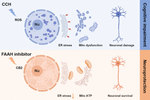Journal of Neuroimmune Pharmacology ( IF 5.2 ) Pub Date : 2024-01-12 , DOI: 10.1007/s11481-024-10098-x Da Peng Wang 1, 2 , Kai Kang 3, 4 , Jian Hai 2 , Qiao Li Lv 5 , Zhe Bao Wu 1, 6

|
Augmentation of endoplasmic reticulum (ER) stress may trigger excessive oxidative stress, which induces mitochondrial dysfunction. The fatty acid amide hydrolase inhibitor, URB597, shows anti-oxidation characteristics in multiple neurological disorders. The present study aimed to determine whether inhibition of ER stress was involved in the protective effects of URB597 against chronic cerebral hypoperfusion (CCH)-induced cognitive impairment. Hippocampal HT-22 cells were exposed to oxygen-glucose deprivation. The cell viability, apoptosis, ER stress, mitochondrial ATP, and oxidative stress levels were assessed following treatment with URB597, benzenebutyric acid (4-PBA), and thapsigargin (TG). Furthermore, the effects of URB597 on ER stress and related pathways were investigated in the CCH animal model, including Morris water maze testing of cognition, western blotting analysis of ER stress signaling, and transmission electron microscopy of mitochondrial and ER ultrastructure changes. The results suggested that cerebral ischemia caused ER stress with upregulation of ER stress signaling-related proteins, mitochondrial dysfunction, neuronal apoptosis, ultrastructural injuries of mitochondria-associated ER membranes, and cognitive decline. Co-immunoprecipitation experiments confirmed the interaction between CB2 and β-Arrestin1. Inhibiting ER stress by URB597 improved these changes by activating CB2/β-Arrestin1 signaling, which was reversed by the CB2 antagonist, AM630. Together, the results identified a novel mechanism of URB597, involving CCH-induced cognitive impairment alleviation of CB2-dependent ER stress and mitochondrial dysfunction. Furthermore, this study identified CB2 as a potential target for therapy of ischemic cerebrovascular diseases.
Graphical Abstract
中文翻译:

缓解 CB2 依赖性 ER 应激和线粒体功能障碍可改善慢性脑灌注不足引起的认知障碍
内质网(ER)应激的增强可能引发过度的氧化应激,从而导致线粒体功能障碍。脂肪酸酰胺水解酶抑制剂 URB597 在多种神经系统疾病中显示出抗氧化特性。本研究旨在确定URB597对慢性脑灌注不足(CCH)引起的认知障碍的保护作用是否与ER应激的抑制有关。海马 HT-22 细胞暴露于氧-葡萄糖剥夺条件下。用 URB597、苯丁酸 (4-PBA) 和毒胡萝卜素 (TG) 处理后,评估细胞活力、细胞凋亡、内质网应激、线粒体 ATP 和氧化应激水平。此外,在CCH动物模型中研究了URB597对内质网应激和相关通路的影响,包括认知的Morris水迷宫测试、内质网应激信号的蛋白质印迹分析以及线粒体和内质网超微结构变化的透射电子显微镜。结果表明,脑缺血引起内质网应激,导致内质网应激信号相关蛋白上调、线粒体功能障碍、神经元凋亡、线粒体相关内质网膜超微结构损伤和认知能力下降。免疫共沉淀实验证实了 CB2 和 β-Arrestin1 之间的相互作用。 URB597 抑制 ER 应激可通过激活 CB2/β-Arrestin1 信号传导改善这些变化,而 CB2 拮抗剂 AM630 可逆转该信号传导。总之,结果确定了 URB597 的一种新机制,涉及 CCH 诱导的认知障碍缓解、CB2 依赖性 ER 应激和线粒体功能障碍。此外,这项研究确定CB2是治疗缺血性脑血管疾病的潜在靶点。




















































 京公网安备 11010802027423号
京公网安备 11010802027423号